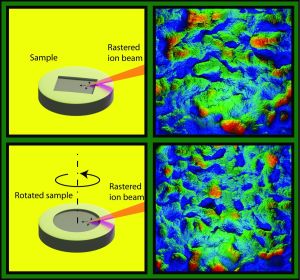After modeling single impact events, it became clear that the important issue to the experimentalists was depth profiling and that we needed to figure out a way to efficiently model the repetitive bombardment process. We developed a divide and conquer protocol to make modeling repetitive bombardment computationally tractable. The essence of the divide and conquer protocol is to extract a subsystem of the particles for each impact and after the individual calculation is finished then reinsert the particles into the master sample.
Repetitive Bombardment Animation
A movie that shows the effect of repetitive bombardment is multiple_20keVAu3 bombardment of a Ag surface. The file is 220Mb so be patient. Animations of individual impacts are given in the references listed below.
Application
An example of where the repetitive bombardment simulations are used to interpret experimental results is a study of the effect of sample rotation on the quality of the depth profile. The simulations show that bombarding at a grazing angle along only one azimuthal direction creates a ridge and valley structure on the surface. Sample rotation prevents the ridge build-up and creates a smoother surface.
Divide & Conquer key publications
- A Computational Investigation of C60 Depth Profiling of Ag: Molecular Dynamics of Multiple Impact Events, M.F. Russo, Z. Postawa and B.J. Garrison, J. Phys. Chem. C, 113, 3270-3276 (2009). This publication contains four animations. DOI: 10.1021/jp808706
- Molecular dynamics study of the effect of surface topography on sputtering induced by 20 keV Au3 and C60 clusters, R. Paruch, L. Rzeznik, M.F. Russo, Jr., B.J. Garrison, Z. Postawa, J. Phys. Chem., 114, 5532-5539 (2010). DOI: 10.1021/jp906139d [Cover Art]
- Effect of Sample Rotation on Surface Roughness with keV C60 Bombardment in Secondary Ion Mass Spectrometry (SIMS) Experiments, B. J. Garrison and Z. Postawa, Chem. Phys. Lett., Frontiers Article, 506, 129-134, (2011) 10.1016/j.cplett.2011.03.003 [Cover Art]


